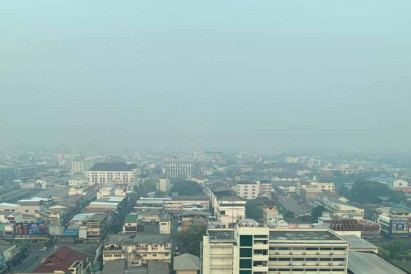
People in upper northern areas of Thailand were still choking on hazardous levels of smog on Wednesday.
Red-zone levels of ultra fine dust were recorded in 20 areas, where PM2.5 levels were above 90 microgrammes per cubic metre (µg/m³), which was hazardous to health, the Department of Pollution Control reported.
As of 11am, PM2.5 levels nationwide during the previous 24 hours ranged from 10-356 microgrammes per cubic metre (µg/m³). The government-set safe level is 50 µg/m³.
In Bangkok and surrounding provinces, PM2.5 levels were 29-99 µg/m³. Twenty-six areas were over the safe treshold of 50 µg/m³ and one spot on Kanchanapisek road in Bang Khun Thian district in the red zone with 99 µg/m³.
In the North, the PM2.5 levels ranged from 35-356 µg/m³. Twenty-eight areas were over the safe level of 50 µg/m³ and 20 of them were in the red zone with over 90 µg/m³. The highest PM2.5 level, 356 µg/m³, was recorded in tambon Wiang Tai of Pai district, Mae Hong Son province. Other spots in the red zone were in Chiang Rai, Chiang Mai, Lampang, Nan, Phrae and Phayao provinces.
In the Northeast, the PM2.5 levels ranged from 33-125 µg/m³. Eight areas were over the safe level and three of them in the red zone – 100 µg/m³ in tambon Kut Pong, Muang district, Loei province; 125 µg/m³ in tambon Meechai, Muang district, Nong Khai province; and 103 µg/m³ in tambon Bung Kan in Muang district, Bung Kan province.
In the Central region, ultra-fine dust levels were 32-63 µg/m³ – with seven areas over the safe treshold of 50 µg/m³.
In the East, PM2.5 levels ranged from moderate to very good.
The Pollution Control Department forecast is that on April 6-7 the PM2.5 levels in Bangkok and its vicinity will mostly be in the safe zone. In the North, especially in areas adjacent to neighbouring countries, the situation would have to be closely monitored because of the stagnant air over the region.

